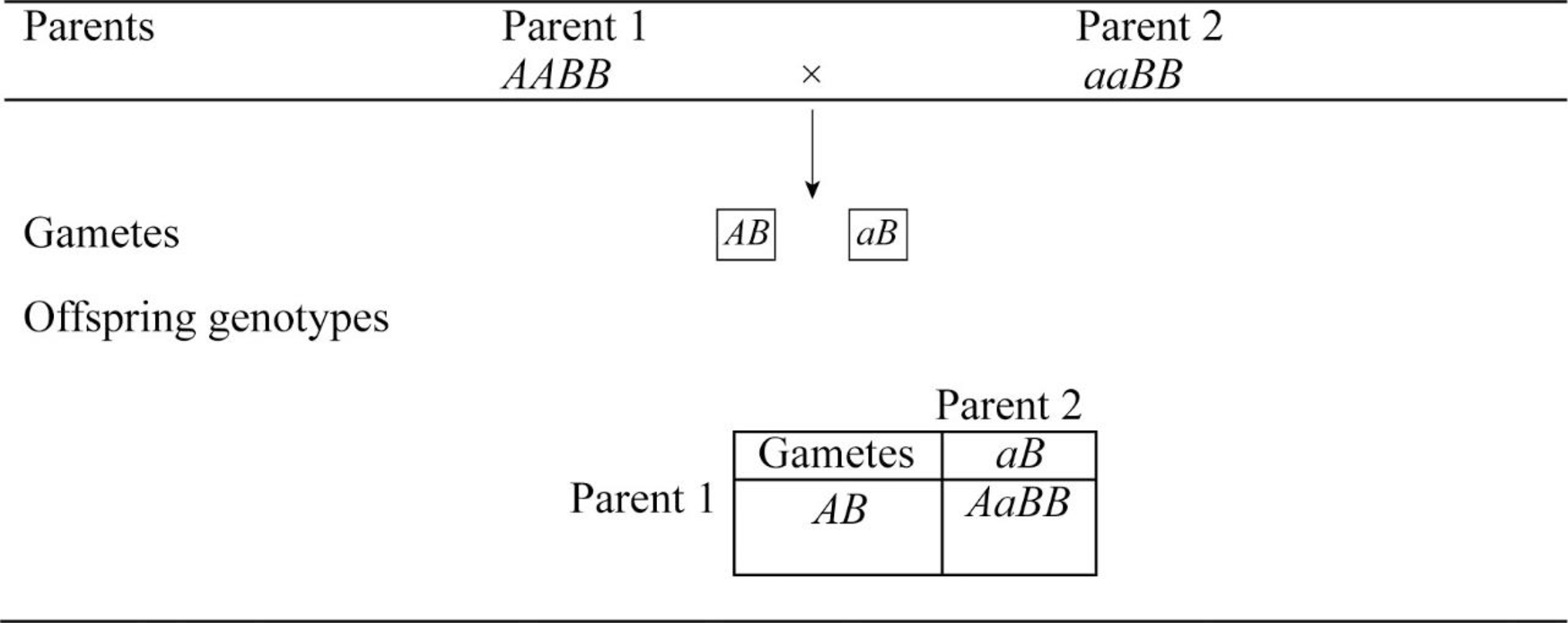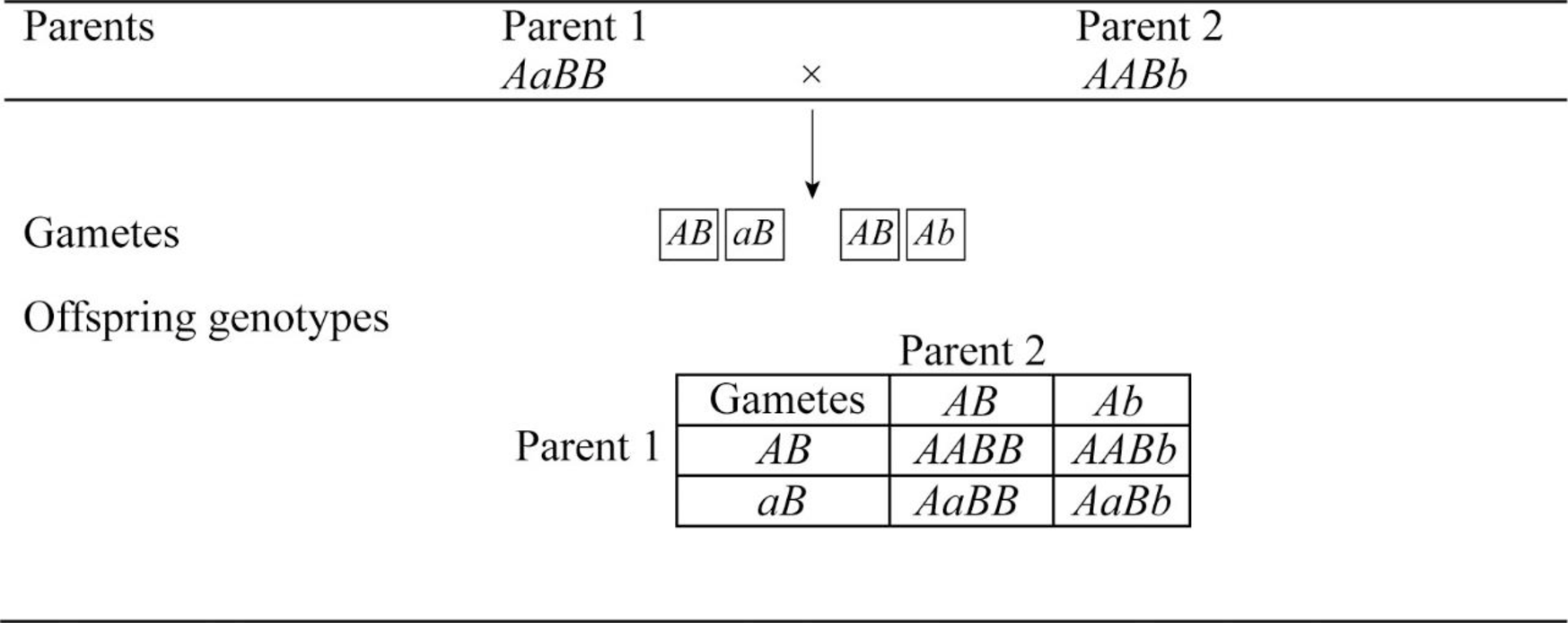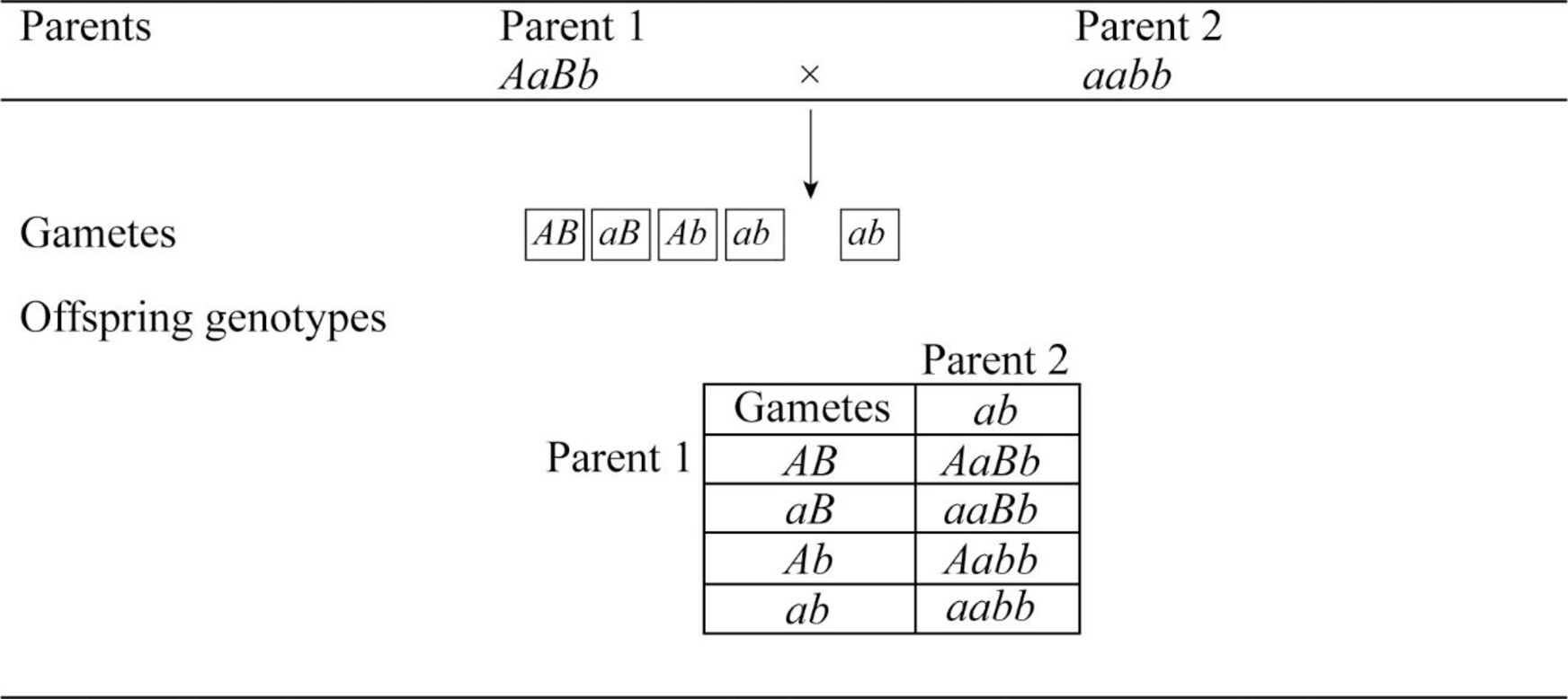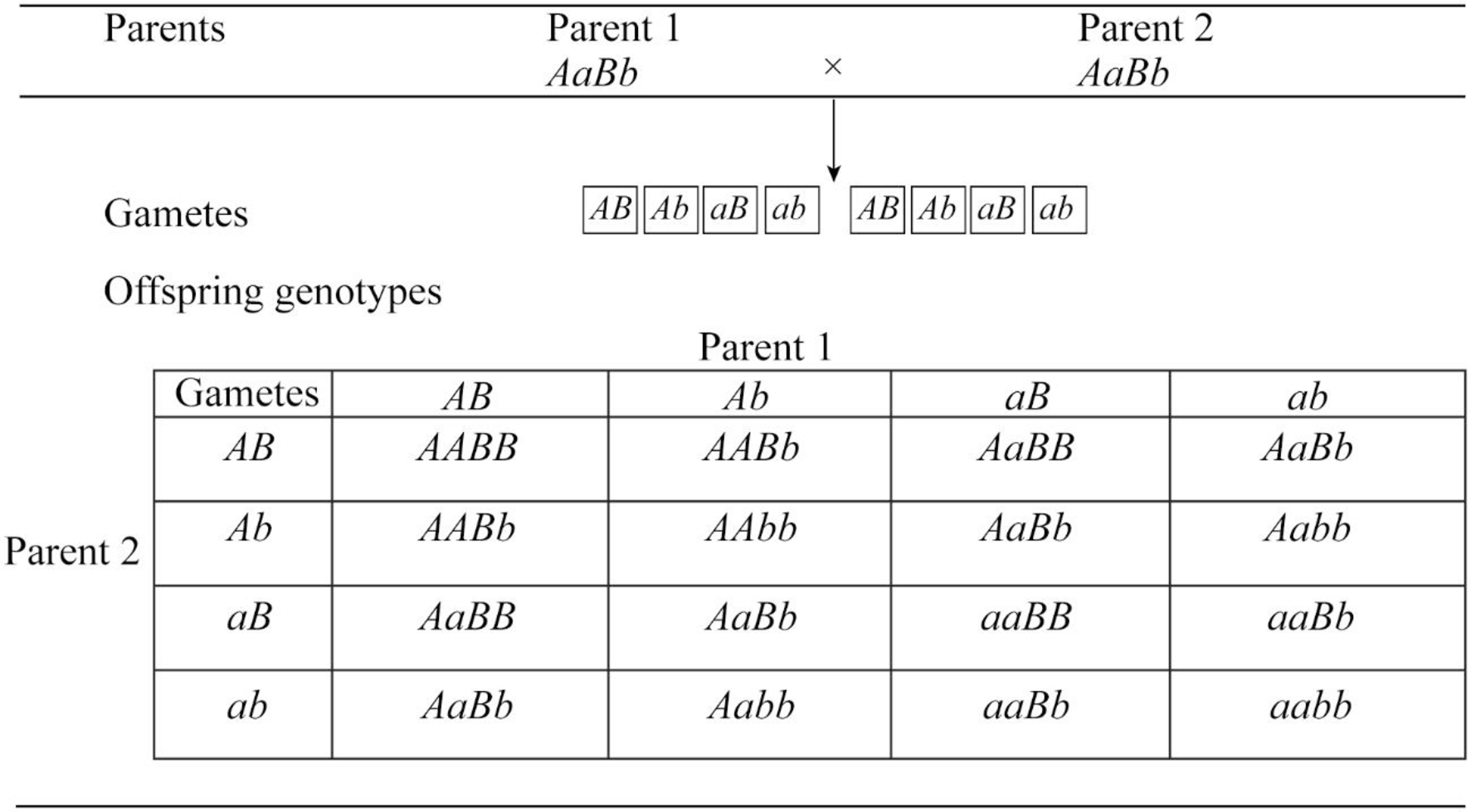
Concept explainers
Still referring to Problem 1, what will be the possible genotypes of offspring from the following matings? With what frequency will each genotype show up?
- a. AABB × aaBB
- b. AaBB × AABb
- c. AaBb × aabb
- d. AaBb × AaBb
a.
To predict: The predicted genotype frequencies among the offspring for the mating AABB × aaBB.
Introduction: The law of independent assortment and law of segregation are the laws proposed by Gregor Johann Mendel, a geneticist. Mendel proposed the law of independent assortment based on the results of monohybrid cross that “two alleles at any locus tend to separate from each other during meiosis, so they end up in different gametes”. Mendel proposed the law of independent assortment based on the results of dihybrid cross that “alleles at one locus tend to assort into gametes independently of alleles at other loci”. The number of possible allele combination for the given genotype is given by the formula 2n where “n” is the number of heterozygous alleles that are present.
Explanation of Solution
A monohybrid cross is constructed with Punnett square for the parents having the genotype AABB and aaBB.

All the offspring have the same genotype AaBB. Therefore, there is no genotype frequency.
b.
To predict: The predicted genotype frequencies among the offspring for the mating AaBB × AABb.
Introduction: The law of independent assortment and law of segregation are the laws proposed by Gregor Johann Mendel, a geneticist. Mendel proposed the law of independent assortment based on the results of monohybrid cross that “two alleles at any locus tend to separate from each other during meiosis, so they end up in different gametes”. Mendel proposed the law of independent assortment based on the results of dihybrid cross that “alleles at one locus tend to assort into gametes independently of alleles at other loci”. The number of possible allele combination for the given genotype is given by the formula 2n where “n” is the number of heterozygous alleles that are present.
Explanation of Solution
A monohybrid cross is constructed with Punnett square for the parents having the genotype AaBB and AABb.

The following is the frequency of genotypes.
Total number of possible genotypes = 4.
AABB=
AABb=
AaBB=
AaBb =
The frequency of all four genotypes is 25%.
c.
To predict: The predicted genotype frequencies among the offspring for the mating AaBb × aabb.
Introduction: The law of independent assortment and law of segregation are the laws proposed by Gregor Johann Mendel, a geneticist. Mendel proposed the law of independent assortment based on the results of monohybrid cross that “two alleles at any locus tend to separate from each other during meiosis, so they end up in different gametes”. Mendel proposed the law of independent assortment based on the results of dihybrid cross that “alleles at one locus tend to assort into gametes independently of alleles at other loci”. The number of possible allele combination for the given genotype is given by the formula 2n where “n” is the number of heterozygous alleles that are present.
Explanation of Solution
A monohybrid cross is constructed with Punnett square for the parents having the genotype AaBb and aabb

The following is the frequency of genotypes.
Total number of possible genotypes = 4.
AABB=
aaBB=
Aabb=
aabb =
The frequency of all four genotypes is 25%.
d.
To predict: The predicted genotype frequencies among the offspring for the mating AaBb × AaBb.
Introduction: The law of independent assortment and law of segregation are the laws proposed by Gregor Johann Mendel, a geneticist. Mendel proposed the law of independent assortment based on the results of monohybrid cross that “two alleles at any locus tend to separate from each other during meiosis, so they end up in different gametes”. Mendel proposed the law of independent assortment based on the results of dihybrid cross that “alleles at one locus tend to assort into gametes independently of alleles at other loci”. The number of possible allele combination for the given genotype is given by the formula 2n where “n” is the number of heterozygous alleles that are present.
Explanation of Solution
A monohybrid cross is constructed with Punnett square for the parents having the genotype AaBb and AaBb.

The following is the frequency of genotypes.
Total number of possible genotypes = 16.
AABB=
AABb=
AaBB=
AaBb=
AAbb=
Aabb=
aaBB=
aaBb=
aabb=
The frequency of genotypes AABB, aaBB , AAbb and aabb is 6.25%.
The frequency of genotypes AaBB, AABb, aaBb and Aabb is 12.5%.
The frequency of genotypes AaBb is 25%.
Want to see more full solutions like this?
Chapter 19 Solutions
EBK HUMAN BIOLOGY
- What is this?arrow_forwardMolecular Biology A-C components of the question are corresponding to attached image labeled 1. D component of the question is corresponding to attached image labeled 2. For a eukaryotic mRNA, the sequences is as follows where AUGrepresents the start codon, the yellow is the Kozak sequence and (XXX) just represents any codonfor an amino acid (no stop codons here). G-cap and polyA tail are not shown A. How long is the peptide produced?B. What is the function (a sentence) of the UAA highlighted in blue?C. If the sequence highlighted in blue were changed from UAA to UAG, how would that affecttranslation? D. (1) The sequence highlighted in yellow above is moved to a new position indicated below. Howwould that affect translation? (2) How long would be the protein produced from this new mRNA? Thank youarrow_forwardMolecular Biology Question Explain why the cell doesn’t need 61 tRNAs (one for each codon). Please help. Thank youarrow_forward
- Molecular Biology You discover a disease causing mutation (indicated by the arrow) that alters splicing of its mRNA. This mutation (a base substitution in the splicing sequence) eliminates a 3’ splice site resulting in the inclusion of the second intron (I2) in the final mRNA. We are going to pretend that this intron is short having only 15 nucleotides (most introns are much longer so this is just to make things simple) with the following sequence shown below in bold. The ( ) indicate the reading frames in the exons; the included intron 2 sequences are in bold. A. Would you expected this change to be harmful? ExplainB. If you were to do gene therapy to fix this problem, briefly explain what type of gene therapy youwould use to correct this. Please help. Thank youarrow_forwardMolecular Biology Question Please help. Thank you Explain what is meant by the term “defective virus.” Explain how a defective virus is able to replicate.arrow_forwardMolecular Biology Explain why changing the codon GGG to GGA should not be harmful. Please help . Thank youarrow_forward
- Stage Percent Time in Hours Interphase .60 14.4 Prophase .20 4.8 Metaphase .10 2.4 Anaphase .06 1.44 Telophase .03 .72 Cytukinesis .01 .24 Can you summarize the results in the chart and explain which phases are faster and why the slower ones are slow?arrow_forwardCan you circle a cell in the different stages of mitosis? 1.prophase 2.metaphase 3.anaphase 4.telophase 5.cytokinesisarrow_forwardWhich microbe does not live part of its lifecycle outside humans? A. Toxoplasma gondii B. Cytomegalovirus C. Francisella tularensis D. Plasmodium falciparum explain your answer thoroughly.arrow_forward
- Select all of the following that the ablation (knockout) or ectopoic expression (gain of function) of Hox can contribute to. Another set of wings in the fruit fly, duplication of fingernails, ectopic ears in mice, excess feathers in duck/quail chimeras, and homeosis of segment 2 to jaw in Hox2a mutantsarrow_forwardSelect all of the following that changes in the MC1R gene can lead to: Changes in spots/stripes in lizards, changes in coat coloration in mice, ectopic ear formation in Siberian hamsters, and red hair in humansarrow_forwardPleiotropic genes are genes that (blank) Cause a swapping of organs/structures, are the result of duplicated sets of chromosomes, never produce protein products, and have more than one purpose/functionarrow_forward
 Human Biology (MindTap Course List)BiologyISBN:9781305112100Author:Cecie Starr, Beverly McMillanPublisher:Cengage Learning
Human Biology (MindTap Course List)BiologyISBN:9781305112100Author:Cecie Starr, Beverly McMillanPublisher:Cengage Learning Biology (MindTap Course List)BiologyISBN:9781337392938Author:Eldra Solomon, Charles Martin, Diana W. Martin, Linda R. BergPublisher:Cengage Learning
Biology (MindTap Course List)BiologyISBN:9781337392938Author:Eldra Solomon, Charles Martin, Diana W. Martin, Linda R. BergPublisher:Cengage Learning Concepts of BiologyBiologyISBN:9781938168116Author:Samantha Fowler, Rebecca Roush, James WisePublisher:OpenStax College
Concepts of BiologyBiologyISBN:9781938168116Author:Samantha Fowler, Rebecca Roush, James WisePublisher:OpenStax College Biology: The Unity and Diversity of Life (MindTap...BiologyISBN:9781305073951Author:Cecie Starr, Ralph Taggart, Christine Evers, Lisa StarrPublisher:Cengage Learning
Biology: The Unity and Diversity of Life (MindTap...BiologyISBN:9781305073951Author:Cecie Starr, Ralph Taggart, Christine Evers, Lisa StarrPublisher:Cengage Learning
 Biology: The Dynamic Science (MindTap Course List)BiologyISBN:9781305389892Author:Peter J. Russell, Paul E. Hertz, Beverly McMillanPublisher:Cengage Learning
Biology: The Dynamic Science (MindTap Course List)BiologyISBN:9781305389892Author:Peter J. Russell, Paul E. Hertz, Beverly McMillanPublisher:Cengage Learning





